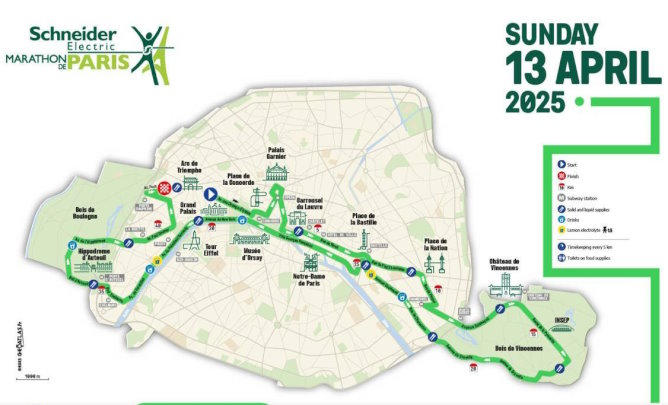Paris Marathon 2025. Marathon route
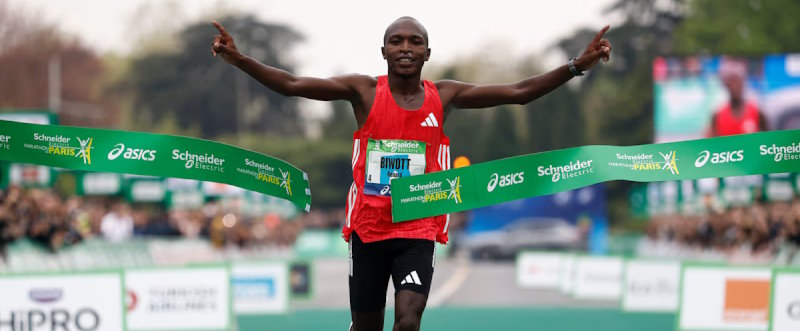
Paris Marathon 2026 will take place on Sunday, 12 April 2026. Paris Marathon 2025 took place on Sunday April 13. The Kenyan Benard Biwott (2:05:25) claimed the men's race and the Ethiopian Bedatu Hirpa (2:20:45) took the women's race. This marathon has a scenic route with an elevation of 144 meters (474 feet). Sporting events in Paris.
Paris Marathon 2026
The 49ᵗʰ edition of Paris Marathon will take place on Sunday, 12 April 2026. The start time is scheduled in the morning, around 8:00 AM for the elite wave, from the Avenue des Champs-Élysées.
The registration period is open. Check registration web site.
A major change for 2026: the organisers have announced that no plastic bottles or disposable cups will be provided at the refreshment stations. Participants will need to carry their own reusable container (flask, foldable cup, etc.).
According to published information, the entry fee for the marathon in 2026 starts from ≈ 135 euros for the “First” tier (early registration) and rises for subsequent tiers.
Paris Marathon route
The Paris Marathon is one of the world's most scenic marathons. The route is not as flat as in Berlin and London, making it difficult to establish world records. Download Paris Marathon 2025 route map. Download Paris Marathon 2025 route elevation.
The starting line of the Marathon is in Champs-Elysées. Runners head downhill before passing through Place de la Concorde, Opéra Garnier and returning to Rue de Rivoli. The route then passes the Tuileries Gardens and Louvre Museum, goes round the Place de la Bastille and on to Boulevard Soult towards Bois de Vincennes. A wide loop in Bois de Vincennes returns runners to the heart of the city and Rue de Charenton, the halfway point.
The inward stretch follows the course of the Seine River, passing Ile de la Cité, going under the Pont Neuf and through tunnels. There is a drink station and foot massage at Trocadéro, facing the Eiffel Tower. The route then continues along the Seine, before branching east towards Bois de Boulogne, finally emerging for the final 200 metres and the finish line in Avenue Foch.
Paris Marathon 2025 route is the same traditional marathon route.

The Paris Marathon passes along the Seine River
Paris Marathon route map
Paris Marathon elevation
Minimum Elevation: 30m (99 feet). Maximum Elevation: 69m (227 feet).
Elevation Gain: 144m (474 feet). Elevation Loss: 135m (443 feet).
Paris semi marathon and 20km 2025
You missed the Marathon or don't feel fit for it.
On March 8 2026, participate to Paris semi marathon, called Harmonie Mutuelle Semi de Paris, or on October 12 2025, to Paris 20 kilometers, called Vredestein 20km de Paris. Two great city races, as scenic as the Marathon and a lot easier.
Paris marathon route detailed
The route of the Paris marathon is not easy, compared to other great marathons such as the London or Berlin Marathons which are perfect places to break own marathon record. But it is a mythical one. The 42.195 km are located in the scenic right bank of the Seine River. The route looks like a long visit running. For those who already know the city, discovering it as a runner in the middle of streets closed to traffic offers a unique sensation.

The profile of the Paris Marathon is not flat. Nothing insurmountable on this route, but to aim for a big time on marathon, the flatter it is, the better. The series of small climbs and especially the formidable coast at kilometer 34 make Paris a beautiful route, but a route more difficult than the other big marathons already mentioned.

At the start of the Paris Marathon, some runners will lose any chance of a good time as they will go quickly, too fast. The start on the Champs Elysees Avenue is downhill and the atmosphere is crazy. This is in addition to the traditional sensations of flying after slowing down the training in the last weeks. This departure of the Paris Marathon must really be done with the impression of keeping the hand brake on. If you lose a few seconds with the traffic, do not worry, do not annoy you either, you will regain them thereafter. At this point, you just have to try to keep your energy to the maximum for the future. Once you are well in your pace, enjoy the moment and pass Place de la Concorde.

From kilometer 2 to kilometer 6, it goes down the Rue de Rivoli, the Tuileries Gardens, the Louvre Museum, the Place de la Bastille. It is almost flat and beautiful, enjoy it. After the passage on the street of the Faubourg Saint-Antoine, there is a right turn which hides the first big piece of this marathon route. The rue de Reuilly is to climb with caution. The coast is about 1.2 km long and the percentage of climb is progressive. In other words, the bottom is easier than the top. You can lose feathers if you climb too fast. This coast is followed by a descent to the equivalent percentage. You can gradually revive the pace, but be careful not to overdo it either. Remember to preserve your muscles for the future. Relaunch gradually and let down by controlling can regain lost time in the climb. Ideally, practicing this way of going down to training can do it perfectly on the day. The Rue de Reuilly is hard and if the Bois de Vincennes is simpler on paper, the alternation of small ascents and descents can also have effects on the future. It is necessary to continue climbing the false plates without forcing and to go down while controlling. It is quiet, you just hear the breath and pace of runners. Ideal to stay focused. We are still fresh in this part and we try to keep as much energy as possible for the second part of the race.

The return to Paris downtown is one of the moments that marks the Paris Marathon. People are here. The numerous and noisy fanfares. We take a good boost and adrenaline is instinctively accelerating if we do not continue to control. Enjoying while avoiding excitement allows to pass these kilometers without realizing it. A short climb brings us again to the Bastille and a refueling before diving to the river banks. Diving that will give a good sign on the condition of the muscles with a half marathon in the legs. The arrival on the banks of the Seine River is very pleasant. There, it is flat and we can unroll its stride. It is here that we can take stock of the legs and decide the rest of the race.

Accelerate a few seconds to km if you feel in great shape. Maintain the pace or, if it is already complicated, go on a plane B. In any case you have to keep running lazily to approach the tunnels. Because from the first tunnel, it gets tough. The first is the tunnel des Tuileries. 1km long, it offers a very strange feeling, especially a day of great sun, Already going down hurts, the descent is not really progressive. And then on this long tunnel, our eyes are used to the sun and have trouble with this sudden darkness and a feeling of lack of air. Fortunately there are people to put a little atmosphere. There are 3 other tunnels which form a succession of descents and short but dry ascents which draw little by little the physical resources. As at the beginning of the race, the technique is to go down smoothly and go up without pushing too hard not to get tired more than reason. All this leads to the Eiffel Tower and the 30th km.

A short climb of 250 m Boulevard Exelmans announces the color. To find it difficult is very bad sign for what happens next. Boulevard Suchet is a 500 m coastline with an average of 3%, with passages over 5%. A coast that would have been used regardless of the place of the route of the Paris Marathon. But when it comes to kilometer 34 of a marathon. Those who have not yet hit the wall of the marathon will have every chance to taste it if they were close. After Bois de Boulogne, at Porte Dauphine, this big roundabout that points to the 42 mark. And the arrival on the Avenue Foch. Oddly, the adrenaline of the arrival will give back some strength and we will be able to cover these last meters full of emotion. Arrive on the green carpet and cut the line. Successful race or not, the emotion will be intense.

Paris Marathon 2025 men's race
African runners once again dominated the Schneider Electric Marathon de Paris, the biggest marathon on earth.
Nine men reached km 30 in the lead group, but the Kenyan Benard Biwott, a few weeks shy of his 23rd birthday, unleashed a devastating acceleration at km 33 that blew the group to smithereens. He opened up a decisive gap in no time and cruised home in 2:05:25, just 54 seconds off the course record still held by fellow Kenyan Elisha Rotich, who had to settle for twelfth this time. He succeeded the Ethiopian Mulugeta Uma as champion and delivered the sixteenth win for Kenya in Paris.
The Djiboutian Ibrahim Hassan took second in 2:06:13, with another Kenyan, Sila Kiptoo rounding out the podium in 2:06:21.

Benard Biwott won men's title in 2025
Paris Marathon 2025 women's race
Ethiopia's Bedatu Hirpa finished 1st in the women’s race with a time of 2:20:45. Her margin of victory was 4 seconds ahead of compatriot Dera Dida, who finished in 2:20:49. The course record for the women’s Paris Marathon, set by Judith Jeptum in 2022, remains at 2:19:48. So while Bedatu Hirpa’s time was impressive, it didn’t break the record.
Third place went to Angela Tanui of Kenya in 2:21:07.
After a cautious first half, a group of four runners broke away in the final 10 km. Then, on the run-in towards Avenue Foch, Bedatu Hirpa made the decisive move and edged past Dera Dida.
This marked Bedatu Hirpa’s second marathon win of the year, the first being in Dubai, where she set a personal best of 2:18:27.

Bedatu Hirpa won women's title in 2025
Paris Marathon 2024
50 000 runners participated to the 47th edition of the Paris Marathon which took place on Sunday April 7 2024.
2h05'33 is the time achieved by Ethiopian Mulegata Uma. The 26-year-old athlete won the longest distance for the first time. He was able to get ahead of the favorites including Titus Kipruto, dropped 2.5km from the finish but author of a thunderous comeback who took second place in 2h05'48. Elisha Rotich, back in the discipline after two years of absence, took third place.
Ethiopian runners Mestawut Fikir and Enat Tirusew fought a fierce battle to win the women's race. Mestawut Fikir won in 2h20'45.
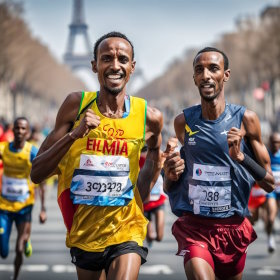
Mulegata Uma won men's title in 2024
Paris Marathon 2023
52 000 runners participated to the 46th edition of the Paris Marathon which took place on Sunday April 2 2023.
20 year old Ethiopian Abeje Ayana won it in 2h07'15''. Kenyan Helah Kiprop won the women title in 2h23'19".
This very scenic city marathon kicked off at 8am in the Champs-Elysées, passed along the Louvre on its way to Bois de Vincennes, then along the banks of the Seine river, the Eiffel Tower and Bois de Boulogne up to the arrival in the fancy Avenue Foch.
The Paris Marathon is also called Schneider Electric Marathon. It is a great combination of sports and sightseeing that we recommend if you are fit.
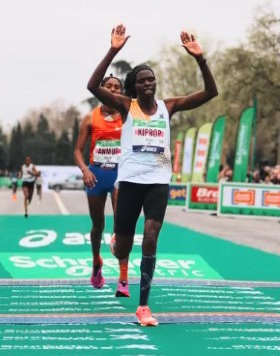
Helah Kiprop won women's title in 2023
Paris Marathon 2022
The Paris International Marathon 2022 took place on Sunday April 3 2022.
45 000 runners participated to this very scenic city marathon. 35 000 runers made it to the finish line. It kicked off at 8am on the Champs-Elysées, passed along the Louvre on its way to Bois de Vincennes, then along the banks of the Seine river, the Eiffel Tower and Bois de Boulogne up to the arrival on the fancy Avenue Foch.
The 2022 Marathon was historic. The Ethiopian Deso Gelmisa won at the end of the 41.295 km race, erasing the record held by Benoît Zwierzchiewski in 2 hours and 05 minutes. The Kenyan Judith Jeptum won in 2h19'48. Julien Casoli won in disabled sport.
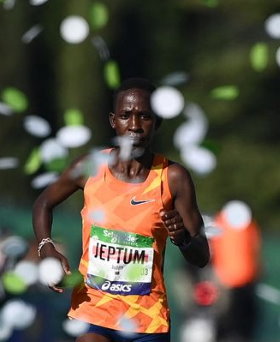
Deso Gelmisa set new all time record in 2022
Paris Marathon 2021
Originally planned on April 5 2020, as a result of the confinement caused by the coronavirus epidemic, the 2020 marathon had been rescheduled to October 2021.
On October 17, Elisha Rotich, an unexpected Kenyan, helped by his carbon shoes, was able to erase in 2:4:21 the Paris marathon record of the iconic Kenenisa Bekele.
The woman boss was Tigist Memuye. The 31-year-old dominated a trio of Ethiopians to win the Paris marathon. Memuye had to work hard in the final to outrun Yenenesh Dinkesa and complete the race in 2:26:12.
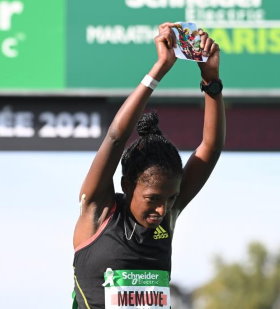
Tigist Memuyé won Paris Marathon 2021
Paris Marathon 2019
On April 14, Ethiopian Gelete Burka and Abrha Milaw won the 2019 Paris Marathon, leading a record 60,000 participants to the finish line.
Milaw won the men’s race with a time of 2:07:50, while Burka was the fastest woman with 2:22:48.
Kenyan Paul Lonyangata, a two-time Paris Marathon winner, was the third-fastest man on Sunday.
In the wheelchair race, Julien Casoli won a third title with a time of 1:36:57.

Gelete Burka won Paris Marathon 2019
Paris Marathon 2018
The 2018 marathon was run April 8 2018. Paul Lonyangata became the first men's runner in 28 years to claim back-to-back Paris marathon titles after he successfully defended his crown in the French capital on Sunday, winning in a time of two hours, six minutes and 25 seconds.
Kenya retained the women's title on Sunday, too, as Betsy Saina raced to victory in two hours, 22 minutes and 56 seconds, just three seconds ahead of countrywoman and silver medalist, Ruth Chepngetich.

Paul Lonyangata won Paris Marathon 2018
Paris Marathon 2017
The 2017 marathon was run April 9 2017. Kenyan husband and wife duo Paul Lonyangata and Purity Rionoripo won the men's and women's races, respectively.
Paul Lonyangata set a personal best of two hours, six minutes and 10 seconds as he finished ahead of one of the favourites, Stephen Chebogout, by 46 seconds in sunny conditions in the French capital.

Paris Marathon on the Seine river banks
Paris Marathon 2016
Paris Marathon 2016 was run April 3 2016. Rising star Cyprian Kotut won the men's event with a time of 2:07:11 just weeks after claiming the half-marathon. Visiline Jepkesho ensured a Kenyan double, as she won the women's marathon with a time of 2:25:52.
Registration statistics 2016:
Number of participants: 57.000
Women: 14,250 and 25%
Men: 42,750 and 75%
French: 35,469 and 57,68%
Foreigners: 21,395 and 42,32%.
Countries with the most participants:
France 35,469, United Kingdom 6,934, United States 1,922, Germany 1,103, Italy 1,060, Spain 1,055, Belgium 922, Brazil 581, Netherlands 529, Swiss 514.
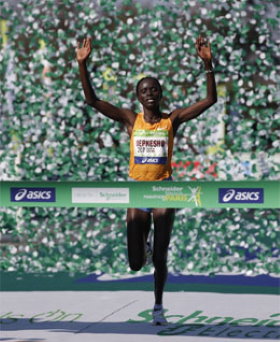
Cyprian Kotut won Paris Marathon 2016
Facts about the Marathon
The marathon is a long-distance running race with an official distance of 42.195 kilometers, usually run on the road. The event was instituted in commemoration of the fabled run of the Greek soldier Pheidippides, a messenger from the Battle of Marathon to Athens, who reported the victory and died soon afterwards.
The marathon was one of the original modern Olympic events in 1896, though the distance was only standardized in 1921. More than 800 marathons are held throughout the world each year. The overwhelming majority of competitors are recreational athletes. The largest marathons have tens of thousands of participants and are often fully booked long in advance. The International Association of Athletics Federations (IAAF), the international governing body for the sport of athletics, keeps track of the world records. The IAAF marathon world record for men is 2:02:57, set by Dennis Kimetto of Kenya at the Berlin 2014 Marathon.
